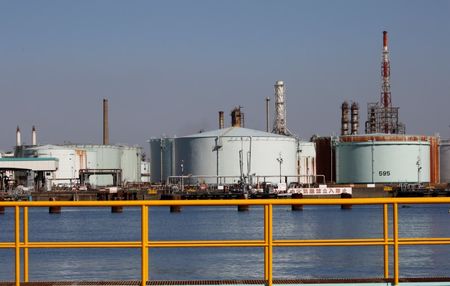Commodities
Oil prices dip on US interest rate jitters, Middle East uncertainty

Investing.com– Oil prices fell Tuesday on concerns high U.S. interest rates will eat into demand this year, amid continued uncertainty in the Middle East.
At 08:15 ET (12:15 GMT), fell 1.8% to $82.17 a barrel, while fell 1.9% to $77.77 a barrel.
US rate fears cloud demand outlook
Fears of high-for-longer U.S. rates were a key point of pressure for crude markets, after a string of Fed officials warned of such a scenario amid sticky inflation.
Vice Chair Philip Jefferson said on Monday that it was too early to tell if the slowdown is “long lasting,” and Vice Chair Michael Barr noted that restrictive policy needs more time, dulling hopes for early cuts.
There are more Fed speakers to digest Tuesday, including Barr once more, as well as FOMC members Thomas Barkin, John Williams and Raphael Bostic, ahead of the release of the of the Fed’s late-April meeting on Wednesday.
High rates are expected to dull activity in the largest economy in the world, likely hitting crude demand, while also limiting money for investment and economic growth, which usually support oil demand.
The International Energy Agency last week trimmed its outlook for crude demand this year, citing concerns over weaker economic conditions due to pressure from interest rates.
On the flip side, the Organization of Petroleum Exporting Countries maintained its demand forecast, citing strength in top exporter China.
China has been a point of confidence for oil demand, especially as Beijing rolled out a string of stimulus measures in recent weeks to support growth.
Political uncertainty in Middle East
Iranian President Ebrahim Raisi, who was seen as a successor to Supreme Leader Ayatollah Ali Khamenei, was killed in a helicopter crash over the weekend, while there are concerns over the health of Saudi King Salman bin Abdulaziz after Crown Prince Mohammed Bin Salman deferred a trip to Japan.
While these events have not had an impact on supplies yet, they have created a degree of political uncertainty in two major oil-producing countries.
OPEC meeting awaited for more cues
Oil markets were also awaiting an in June, where the cartel, along with its allies including Russia, will discuss output policy, including whether to extend the voluntary supply cuts of 2.2 million barrels per day from mainly Saudi Arabia.
The group, known as OPEC+, could well extend some voluntary cuts past their initial June-end deadline if demand fails to pick up.
“As the market waits for clarity from OPEC+ on its output policy for the second half of the year, there are some signs of weakness in the market,” said analysts at ING, in a note.
“Refinery margins have been trending lower for some time, raising the prospect of cuts in refinery runs, particularly in Asia. In addition, the physical crude market is also weaker.”
(Ambar Warrick contributed to this article.)
Commodities
Oil prices rise; U.S. crude inventories plunge, Russia-Ukraine truce eyed
Commodities
India’s Reliance to stop buying Venezuelan oil over US tariffs, sources say
Commodities
Oil prices climb on Venezuela supply worries

 Forex3 years ago
Forex3 years agoForex Today: the dollar is gaining strength amid gloomy sentiment at the start of the Fed’s week

 Forex3 years ago
Forex3 years agoUnbiased review of Pocket Option broker

 Forex3 years ago
Forex3 years agoDollar to pound sterling exchange rate today: Pound plummeted to its lowest since 1985

 Forex3 years ago
Forex3 years agoHow is the Australian dollar doing today?

 Cryptocurrency3 years ago
Cryptocurrency3 years agoWhat happened in the crypto market – current events today

 World3 years ago
World3 years agoWhy are modern video games an art form?

 Commodities3 years ago
Commodities3 years agoCopper continues to fall in price on expectations of lower demand in China

 Economy3 years ago
Economy3 years agoCrude oil tankers double in price due to EU anti-Russian sanctions





























